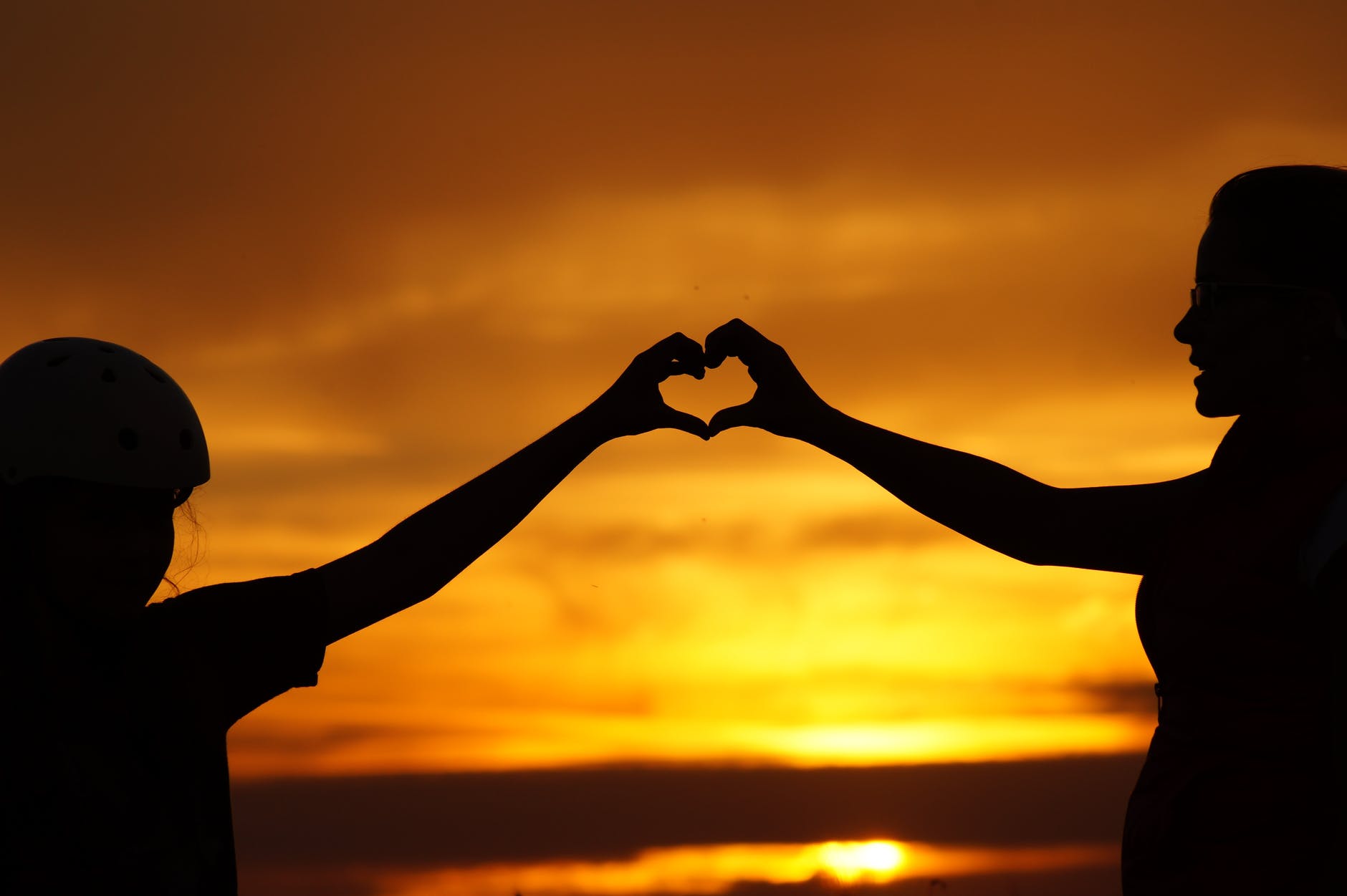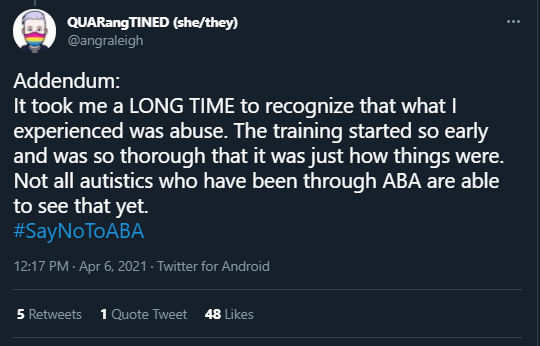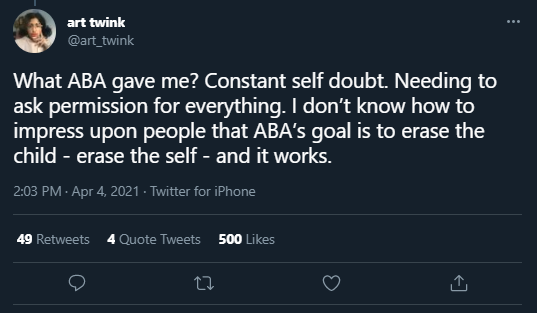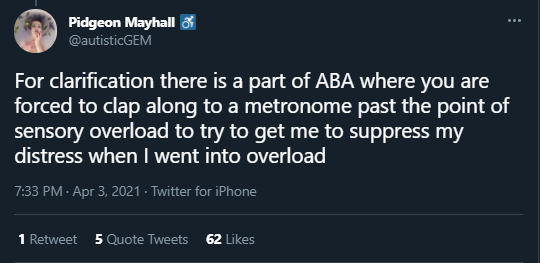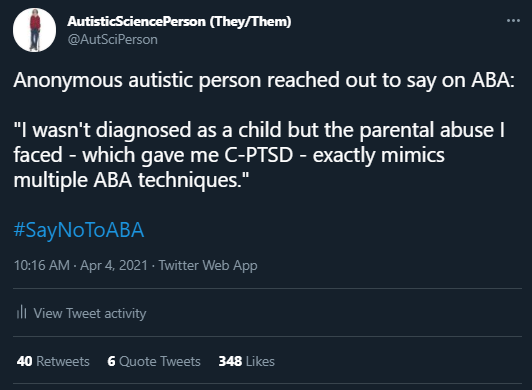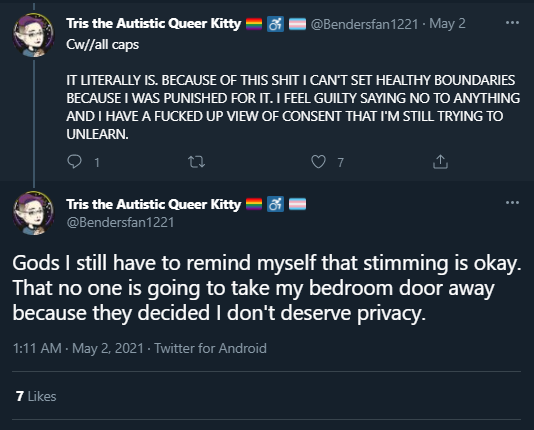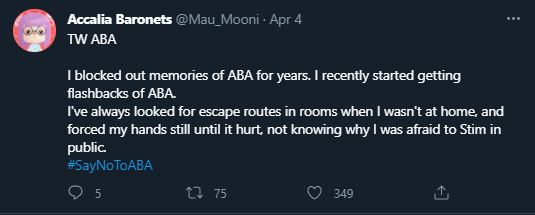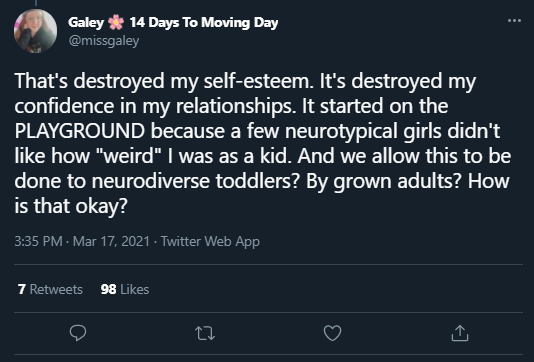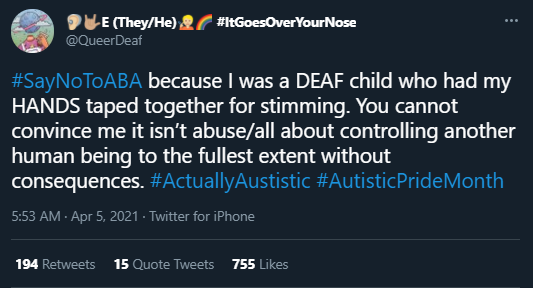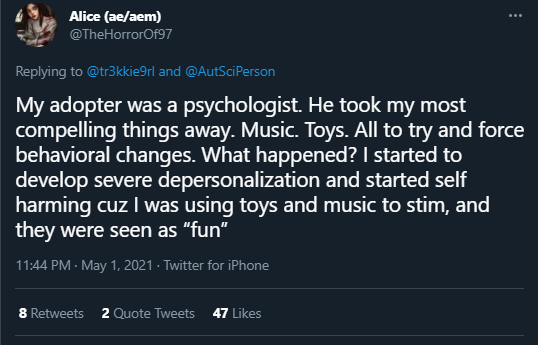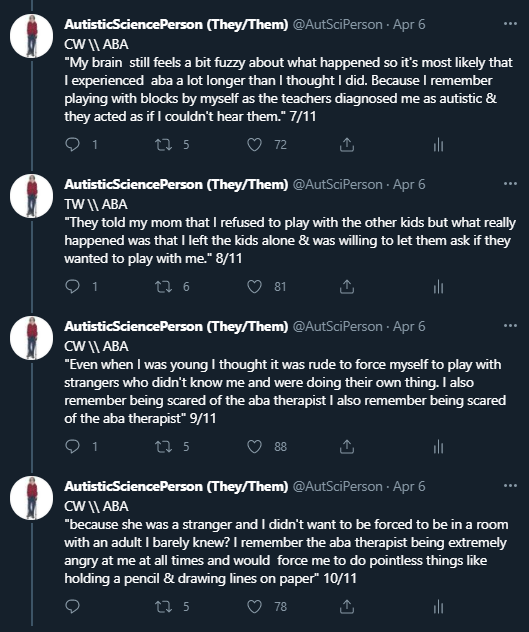You may have heard of “Applied Behavioral Analysis therapy.”
You might think that it must be good for your child because a lot of teachers, therapists, and doctors have endorse it for autistic kids.
Some things you may not know:
Applied Behavioral Analysis therapy teaches autistic kids to hide sensory pain, and increases the likelihood of PTSD and suicidality in autistic people.
Yea, it’s surprising. But it’s also true. #SayNoToABA
Page Outline:
What is Trauma?
ABA and Sensory Sensitivities
What the Research Says
Autistic People’s Real Experiences of ABA Therapy
ABA therapy and consent
Alternatives to ABA
Societal Pressure and Final Thoughts
Polls
Summary:
ABA therapy does not put the child’s emotional well-being and quality of life first. ABA therapy assumes that children simply won’t do things and need to be incentivized to do them through rewards and negative reinforcement(or, lack of rewards). The ABA therapists don’t assume that the autistic kids can’t do what they are asking them to do (do complex physical tasks, or physically speak), or that what they’re asking them to do is painful (such as make eye contact, be in a sensory overwhelming environment). Further, ABA therapy is not child-led, unlike most other therapies. Instead, the ABA therapist themselves and the parent decide what goals the child must meet. ABA therapy also rewards autistic children to hide their pain and distress, and rewards autistic children for “fitting in” to neurotypical norms. Autistic masking, which most of us do for decades, or an entire lifetime, often leads to poor mental health and even increased suicidality. Research on trauma, sensory sensitivities, and the effectiveness of ABA therapy is below.
“After repeated cycles in the classroom, the Autistic child begins to develop PTSD because the neurotypical BCBA is focused on the function of behavior and the compliance of the child, and not what the child is communicating with their behavior.”
Amy Grant from the Therapist Neurodiversity Collective
What Is Trauma?
This podcast talks about how long-term chronic stress and microaggressions can lead to CPTSD.
This is likely how autistic kids in ABA therapy become traumatized.
“Any activation of your stress response, even little, that’s unpredictable and uncontrollable, or prolonged, leads to traumatic changes.” – Dr. Perry
Unlocking Us
“Part of trauma is a situation, an environment, over which we have no control.” – Dr. Brene Brown
ABA Therapy Does Not Acknowledge The “Why” to Behavior
ABA therapy does not allow an autistic child control of their environment. ABA therapy does not allow sensory supports (headphones/sunglasses/fidget toys/weighted blankets/etc.) for autistic kids, or if they do, are simply used as an incentive with a time limit, and not used as a true sensory support. Being in an environment that uses planned ignoring (ignoring a child when they are in distress and/or having a meltdown), that refuses to accommodate their sensory sensitivities, and that rewards them for hiding their sensory pain is traumatic.
Would you ever reward a child for putting their hand on a hot stove?
After you answer “no” to that question, would you consider that situation abusive?
Sensory Sensitivities Are Real and Painful – ABA Denies This
Autistic people’s sensory sensitivities are painful. They are not something that can go away by playing loud sounds or bright lights at us.
Our brains are wired differently in both positive and negative ways, and due to this difference, many of us cannot habituate to stimuli.
“Desensitizing” Doesn’t Work: It’s Physiological, Part of Our Nervous System
If you’re wondering why I asked if you would ever reward a child for putting their hand on a hot stove, this is why:
Playing loud noises to a child, putting scratchy clothes on a child, or making a child sit under bright lights or strong smells without their consent, with known sensory sensitivities, is just as painful and traumatizing as rewarding or even forcing any child to put their hand on a hot stove.
My Experience
I have hyperacusis (eardrum pain with moderately loud sounds) and I have lived 24 years as an undiagnosed autistic person with hyperacusis. I never wore ear protection during that time and I was an anxious wreck. My hyperacusis never got “fixed” by listening to loud sounds over those 24 years (trust me, I tortured myself to “try” to see if it could be, which just left me more fatigued and in pain). It is a part of my neurology. Ear protection has been the necessary and helpful sensory support I have needed all along and has made my quality of life significantly better.
What Does the Research Say?
Research Has Shown that ABA is Unethical, Ineffective, and Even Harmful
Autistic Masking Is Taught in ABA Therapy and Has Life-long Mental Health Consequences
“Camouflaging and unmet support needs appear to be risk markers for suicidality unique to ASC.“
Research article: Risk markers for suicidality in autistic adults
Autistic masking (camoflauging) includes:
- Repressing stimming movements
- Making eye contact with others
- Use NT niceties even if it doesn’t make sense and wastes your energy
- Smile exaggeratingly/change tone of voice/body language to appease others.
- Hide sensory distress (this can mean repressing the urge to grimace, look at a sound, close your eyes, stim, etc. when in sensory pain)
- And much more
Annual Military Report Shows that ABA Therapy Is Not Effective –

The US Military Report from 2020 has shown that ABA does not increase quality of life for autistic children:
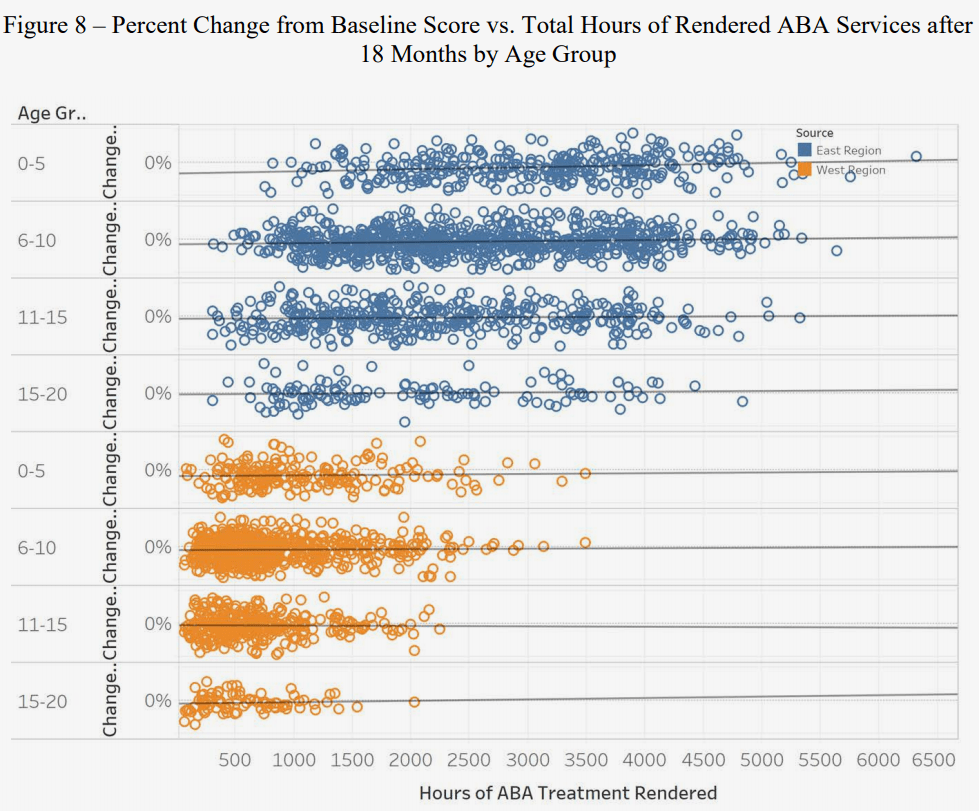
“For the East region, the trend line indicates that beneficiary scores worsened with more hours of ABA services. In the West region, there is no statistically significant correlation between the total number of direct hours rendered and outcome measure scores. The West region trend line demonstrated a flat trend line noting no correlation with rendered hours of ABA services. There does not appear to be a correlation between outcome measures and the number of hours rendered. In other words, the number of hours rendered does not appear to impact outcomes. If the amount of direct ABA services was correlated with improvement, the trend line would demonstrate a statistically significant negative slope. Therefore, any percent change in PAC scores over time (Figure 4) cannot be directly attributed to hours of ABA services provided under the ACD, and could be due to other factors such as developmental growth/maturation and/or other concurrent treatment.”
DoD Annual Report on Autism Care Demonstration Program 2020
Research Shows ABA Therapy is Correlated With PTSD Symptoms:
Evidence of increased PTSD symptoms in autistics exposed to ABA
“Nearly half (46 percent) of the ABA-exposed respondents met the diagnostic threshold for PTSD, and extreme levels of severity were recorded in 47 percent of the affected subgroup. Respondents of all ages who were exposed to ABA were 86 percent more likely to meet the PTSD criteria than respondents who were not exposed to ABA. Adults and children both had increased chances (41 and 130 percent, respectively) of meeting the PTSD criteria if they were exposed to ABA. Both adults and children without ABA exposure had a 72 percent chance of reporting no PTSS (see Figure 1).“
Evidence of increased PTSD symptoms in autistics exposed to applied behavior analysis
For full text, see here
What About Self-Injurious Behaviors (SIBs) Like Headbanging?
Journal Article Quoted Below:
Treating self-injurious behaviors in autism spectrum disorder –
Potential Reasons Behind Headbanging
“Psychologists observe [Self-Injurious Beahviors] SIBs in children and adults in the typical population and have conceptualized SIBs as a result of difficulty regulating extreme negative emotions, and physical and/or psychological pain (Skegg, 2005). Meaning, many of these individuals do not have the skills to regulate or communicate and therefore it is their only way to cope…Research has been fairly transparent that a high proportion of children with ASD with severe impairments use challenging behavior as a form of expression, and even if the behavior is ignored, the child will still engage in SIB in order to try to communicate (Chiang, 2008).”
Shkedy et al. 2019
Why ABA Does Not Help:
A Functional Behavior Assessment or Analysis is a method that is widely used in Applied Behavioral Analysis (ABA) therapy…the principles of behaviorism that are implemented through ABA therapy do not take into account internal processes. Consequently, the FBA was designed to determine the function or cause of external behaviors by identifying external triggers or stimuli...It is unclear why one would assume such an assessment/analysis would also be appropriate to assess the thoughts, feelings, and other internal processes that often determine the function of self-injurious behaviors (especially since we know this is the case for SIBs in the non-autistic population). Some common hypotheses derived from the application of an FBA suggest the function of SIB is likely social attention, access to tangible rewards, to escape or avoid certain activities or situations, or due to internal self-stimulation (Minshawi et al., 2014). It is unclear why one would think these responses are appropriate for someone who is engaging in SIB since these responses do not follow any evidenced-based treatment or theoretical orientation. A psychologist or therapist would not respond to any client this way after discovering their client has been or is engaging in SIB.
Headbanging can be due to experience pain (sensory or physical), or due to lack of an effective method of communication (even highly speaking autistic people can have difficulty expressing emotions and what they need using speech):
“Research has continued to find a high prevalence of challenging behavior in children with ASD who have limited spoken language, and a decrease in these behaviors when teaching functional communication, again supporting the relationship between expressive language skills and challenging or self-injurious behaviors (e.g. Baghdadli et al., 2003; Chiang, 2008; Murphy et al., 2005; Saloviita, 2000)…studies have indicated that the physiological responses resulting in pain from non-suicidal self-injury can be an attempt to heal psychological pain or other pain, especially for individuals with an insufficient stress response.”
Shkedy et al. 2019
The Researcher’s Conclusion
[The FBA] has been inappropriately applied to address SIB to develop hypotheses as to the internal, invisible processes within a child in order to determine why they are engaging in SIB….various behavioral hypotheses and treatment recommendations have arisen from these FBA, despite the inappropriate use of this assessment tool and its inherent methodological flaws….the conclusions for the functions of [self-injurious behavior] reached [in ABA] are varied, inconsistent, and without any scientific basis. Therefore, any treatment recommendations that are derived from an FBA should be considered unreliable since the assessment method in it of itself is unscientific, as it attempts to measure an unobservable construct, which is outside of the sphere of behaviorism and should only be performed by someone trained in psychology.
Is it Really Harmful Though?
Quote Below from How much compliance is too much compliance: Is long-term ABA therapy abuse?
“Interventions that result in years spent trying to force a child to engage in eye contact, condition a child to stop stimming or obey commands such as “hands down,” with no apparent understanding of the function of such behaviors for children with ASD, is undoubtedly abusive and frankly irresponsible when understanding the autistic brain. Research indicates hyperactivity in various areas of the autistic brain which results in overstimulation and can explain a number of symptoms, such as aversive responses to eye-gaze (Dichter, Felder, & Bodfish, 2009; Martineau, Andersson, Barthélémy, Cottier, & Destrieux, 2010; Markram & Markram, 2010). This overstimulation is seen in the over-activation of the amygdala when eye-gaze is held for longer (Dalton et al., 2005; Markram & Markram, 2010). Research also describes the function of stimming in children with ASD similar to that of nail-biting, playing with hair, tapping one’s leg, etc., yet interventions have noted differences in stimming or movement and made arbitrary distinctions between which movements are pathological and which are not (Baron, Groden, & Groden, 2006). Additionally, many stimming movements or behaviors have been shown to be related to stress and anxiety, which can cause unusual sensations and movements to escalate, while others are related to painful sensory hyperactivity (Baron et al., 2006; Brenner, Friedman, & Merritt, 1947). A lifetime of being punished for certain movements, and being forced to engage in eye contact despite the physiological pain and discomfort of doing so, is psychological and physical abuse.“
Sandoval-Norton and Shkedy 2019
What Do Autistic People Who Have Been Through ABA Therapy Have to Say About It?
Read About Real Autistic People’s Experiences of ABA
(TW Restraint, abuse, gaslighting, sensory assault)
Compilation of Autistic Adult’s Experiences in ABA (all images are here)
Why You Didn’t Know Applied Behavioral Analysis Therapy is Harmful:
ABA Therapist Admits that the Parent is the Most Important Person, Not the Autistic Child:
A Closer Look At Why ABA is Unethical:
ABA Therapy Does Not Ask For the Child’s Consent:
Lack of Consent in Action, in Real ABA “Research” Case Studies –
What ABA Would Look Like for Neurotypical Children:
Abuse = Long-term Trauma From Masking
Why It Is So Hard for Autistic People to Communicate Their Distress:
Why Alternative Therapies, Like Occupational And Speech Therapy, Aren’t Foolproof:
Okay, if ABA is bad, What do I do now?
Where to Start for Support:
Get Information on Autism from Autistic Adults:
You can start with This Guide and These Resources
Consider if your child needs any kind of therapy (or not):
What are you getting therapy for?
Autistic people do not need therapy just for “being autistic,”
just like neurotypical people do not need therapy just for being neurotypical.
Co-Occurring Conditions
Any person, autistic or not, may need supports, accommodations, and possibly occupational/music/speech/art/physical therapy for co-occurring conditions, such as –
- dysgraphia
- dyspraxia
- other speech and/or motor disabilities
- dyslexia
- hypermobility or Ehlers-Danlos Syndrome
- sensory hypersensitivities and hyposensitivities (to figure out what sensory sensitivities they have and support them)
- needing to find the best alternative communication device, whether that means AAC (alternative augmentative communication), sign language (ASL/BSL/Makaton), typing, writing, pointing to pictures, etc.
Final Thoughts
Believe Autistic People About Their Experiences
The left side of the second above image is many, many autistic people’s experiences in ABA therapy.
You will have professionals, teachers, other parents constantly pressuring you about ABA. ABA therapy will not help. It teaches autistic kids to hide who they are, to mask, which can lead to increase suicidality and mental health issues years later. It’s really not worth it. If a professional is doing something that is putting your kid in distress – trust your instinct. Don’t let “professionals” teach autistic kids that they are wrong or bad for existing as who they are, implicitly or otherwise.
And if you still disbelieve autistic people about how harmful ABA therapy is, see for yourself, in this video of an ABA therapist doing “drills” on her autistic child. This is what ABA is. Compliance, and trauma.
“An ABA signature “intervention” promises to turn any “problem” behavior into an “adaptive” one. Problem for whom? Adaptive to what? ABA does not offer independent arguments for the immanent social values it manipulates on behalf of the authorities governing the world of the child. A clinician may compel an autistic boy to make eye contact, for example, but cannot say why making eye contact is a value worth pursuing from the child’s perspective. The idea that the boy’s personal growth would take place through a dialectic of conflict between him and his school, or between him and the parents, is ruled inadmissible. The clinician smuggles the interests of institutions into allegedly neutral techniques, disguising social obligations as moral imperatives—and moral imperatives as scientific truths.”
– John Summers, Article on Why ABA is So Prevalent in the US
Reference List and Resources
- The Strategies of ABA – What Parents Should Know Before Making a Decision
- Brené with Oprah Winfrey and Dr. Bruce D. Perry on Trauma, Resilience, and Healing
- Cassidy S, Bradley L, Shaw R, Baron-Cohen S. Risk markers for suicidality in autistic adults. Mol Autism. 2018 Jul 31;9:42. doi: 10.1186/s13229-018-0226-4. PMID: 30083306; PMCID: PMC6069847.
- Annual Report on Autism Care Demonstration Program for FY 2020: Report to the Committee on Armed Services of the Senate and House of Representatives on TRICARE and ABA
- Summary of DoD Report by Dr. Barry Nathan, Therapist Neurodiversity Collective
- Kupferstein, H. Evidence of increased PTSD symptoms in applied behavior analysis. Advances in Autism. 2018 4;1:19-29.
- Shkedy, G., Shkedy, D., & Sandoval-Norton, A. H. Treating self-injurious behaviors in autism spectrum disorder. Cogent Psychology. 2019 6;1
- Sandoval-Norton, A. H., Shkedy, G. How much compliance is too much compliance: Is long-term ABA therapy abuse? Cogent Psychology. 2019 6;1
- Wilkenfield, D. A. McCarthy, A. M. Ethical concerns with applied behavior analysis for autism spectrum “disorder.” Kennedy Institute Ethics 2020 30;1:31-69
- Resources on ABA Therapy by the Therapist Neurodiversity Collective
- Why ABA is So Prevalent in the US
- More Resources on ABA by ABA Therapists, Parents, and Autistic People
- Lawson, R., Aylward, J., White, S. et al. A striking reduction of simple loudness adaptation in autism. Sci Rep 5, 16157 (2015).
- Remington, A., Fairnie, J. A sound advantage: Increased auditory capacity in autism. Cognition 166, 459-465 (2017).
- Giant list of Articles About ABA
- Experience in the World of ABA
Related Posts
About a week ago, I wrote a very long twitter thread directed at parents of autistic kids, and am now putting it in blog form for easy access.
Here are the most common questions I see from parents of autistic kids, answered in this blog post: click here to read more.
